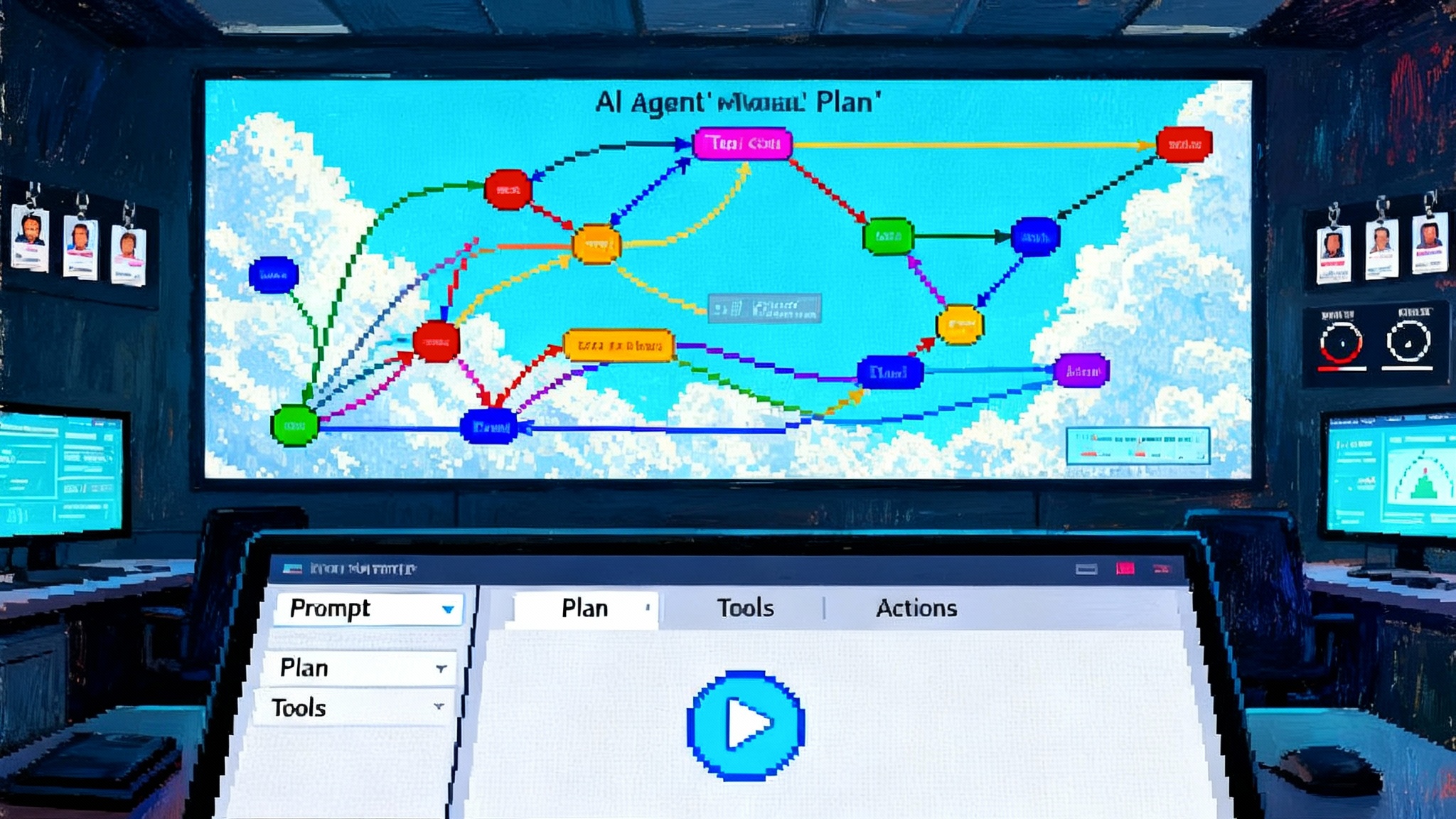ChatGPT’s Agent Goes Cloud‑Scale, And Work Will Follow
OpenAI has folded its Operator browser agent into ChatGPT and is steering the stack toward supervised cloud workers. Here is what cloud‑scale agents mean for SaaS vendors, enterprise IT, and developers, plus a practical checklist to get ready.

The quiet flip from chatbot to worker
OpenAI has been signaling a shift: ChatGPT is no longer just a conversational interface. It is an operator that can act on your behalf. That direction started with the Operator research preview from OpenAI and became explicit when ChatGPT added an agent mode described in the Introducing ChatGPT agent post. The pattern is consistent: the agent reasons, takes actions, pauses for confirmation, and leaves a trail you can review.
What cloud-scale agents actually mean
Cloud-scale is a runtime change, not a slogan. Instead of users babysitting a model in a tab, agents run in managed environments that can persist, parallelize, and coordinate work. Several shifts follow:
- Persistence: agents keep context across multi-step tasks and reappear on a schedule. Weekly reports, rolling code refactors, and compliance checks become recurring jobs rather than manual prompts.
- Supervision by design: the default is not unsupervised autonomy. Agents ask for approval on high-impact steps and hand control back when sensitive actions are required.
- Standard tooling: a stable toolbox replaces ad hoc plug-ins. Visual browsing, code execution, connectors for data sources, and scoped terminal actions form the core.
- Elasticity: many small agents beat one giant one. Tasks shard into subtasks that can be queued, retried, and audited.
Implications for SaaS vendors
If millions of supervised agents will use your web app and APIs, your product and policy will either invite them or repel them.
1) Terms and anti-automation language
- Stop treating every non-human click as abuse. Update Terms of Service to allow supervised, authenticated automation that respects rate limits and site rules.
- Replace blanket bot bans with a clear allowlist policy. Define what is permitted for read, write, and purchase flows when an agent acts for a verified user.
- Publish an agent access policy alongside robots.txt. Document login expectations, sensitive pages that always require human takeover, and incident contacts.
2) Rate limits that reflect jobs, not requests
- Create job-scoped quotas. Cap per-user concurrent jobs and per-workspace daily job budgets, not just requests per minute.
- Offer burstable windows for checkout, claims filing, or ticketing flows. Agents work in bursts, then go quiet.
- Negotiate enterprise agent limits. Provide headers that indicate remaining job capacity so runtimes can pace themselves.
3) Agent-safe APIs and pages
- Add idempotency keys everywhere a write occurs. Agents will retry. Make retries safe.
- Expose preview endpoints that render a near-final diff for review before commit.
- Remove hidden prompts and fragile selectors. Use stable semantic labels and ARIA roles so vision-based agents navigate reliably.
- Provide a safe first-party action API for payments, cancellations, or irreversible deletes.
Implications for enterprises
The move from chat to work turns governance from nice-to-have into must-have. Treat an agent like a contractor with tools, a badge, and monitoring.
1) Identity and trust
- Mint an agent identity per job with its own claims and audit trail.
- Use just-in-time credentials. Grant scopes only when needed. Revoke on completion or timeout.
- Keep agents off primary SSO roles. Prefer dedicated low-privilege roles mapped to minimal task scopes.
2) Least privilege by default
- Start with read scopes. Elevate to write only after a human approves a preview of the change.
- Partition data by case or project to limit blast radius.
- Ring-fence email and finance. Force human takeover for money movement, password changes, and inbox sending.
3) Auditability and evidence
- Record a signed action journal. Capture prompts, steps, previews, approvals, final diffs, and the exact API calls or form submits.
- Store visual evidence when possible. Screenshots or rendered diffs speed legal and compliance reviews.
- Keep a policy map in the log. Note which policy allowed the action, who approved it, and which scopes were active.
4) Controls you can actually operate
- Maintain a domain allowlist and denylist for agent browsing.
- Provide a kill switch per job and per user. Allow pause or stop with rollback of uncommitted work.
- Budget agent time and cost. Treat agents like cloud jobs with quotas.
Implications for developers
Agents are a different engineering animal than chatbots. They must be interruptible, reversible, and inspectable.
1) Reversible by construction
- Dry-run first. Every write action should support a preview.
- Use idempotency keys and upserts for safe retries. Persist keys in job state.
- Design compensating actions so partial commits can be undone.
2) Human in the loop as a feature
- Surface a clean diff so reviewers approve concrete changes, not prose.
- Require explicit approval for irreversible steps with a clear impact summary.
- Offer a takeover mode, then hand control back with state preserved.
3) Robustness to the real web
- Target stable selectors and ARIA roles, not pixel coordinates.
- Handle CAPTCHAs with human takeover. Treat them as escalation points.
- Detect and neutralize prompt injection. Do not execute instructions found in page content unless they match the task plan.
4) Observability like a backend job
- Emit structured logs with timestamps, inputs, outputs, and outcomes.
- Trace across tools. Correlate browser actions, connector calls, and code execution with a shared job ID.
- Persist minimal state to resume after crashes or preemption.
How costs and limits will evolve
Agents consume more than tokens. They use time, network, and headless compute.
- Pricing by job and tool use: expect metering for browsing minutes, code execution, and connector calls in addition to model usage.
- Limits on concurrency: long-running jobs will be treated differently from bursty chat.
- Credits for assistive clarifications: authentication prompts and confirmation clicks often will not count as new jobs.
Finance teams should budget agent spend like a small automation squad. Set cost envelopes for routine jobs and caps with alerts for complex refactors or migrations.
Competitive stakes: the runtime moves to the cloud
Major vendors are converging on similar playbooks: define tasks, wire in identity and data, and run supervised automations with audit and rollback. Tooling depth and integrations will differentiate. For example, NIM blueprints make agents real in enterprise settings, while Gemini turns Chrome into a runtime tightens the browser-to-agent loop. Security posture will be decisive too, as shown in our guide to securing agentic AI after outages.
Expect hybrid deployments. Teams will use vendor agents inside productivity suites and domain-specific agents near line-of-business systems. Winners will meet enterprises where they are and make governance consistent across both worlds.
A practical checklist to start now
SaaS vendors
- Publish an agent access policy and job-aware rate limits.
- Add idempotency keys and preview endpoints for all writes.
- Stabilize UI semantics with labels, roles, and consistent DOM structure.
- Offer a safe API lane for high-impact flows.
Enterprise IT
- Issue per-job identities and use just-in-time scopes.
- Require previews and approvals for irreversible steps.
- Log a signed action journal with visual evidence.
- Maintain allowlists and kill switches for agent browsing.
Developers
- Design for dry-run, diff, approve, commit.
- Build compensating actions and safe retries.
- Persist minimal job state for resume.
- Emit structured, correlated logs across tools.
Safety and supervision are features, not caveats
The most telling design choice in today’s agent systems is built-in supervision. You can watch the narration, take over the browser, and review the action journal. That is an operating model for real companies. OpenAI’s system card outlines stronger safeguards for sensitive domains and takes a precautionary posture on high-risk areas. Do not force autonomy where supervision is cheaper and safer. Start supervised, prove value, then decide which steps to automate end to end.
The bottom line
ChatGPT’s agent is the inflection point where generative AI moves from chat to work. A browser that can act, a code tool that can execute, and connectors that pull in context create a general-purpose worker that fits inside existing controls. As runtimes move into the cloud, competition shifts from model quality alone to identity, safety, developer experience, and evidence. The next year will be defined by fleets of supervised agents doing real jobs under human oversight. If vendors welcome agents with clear policies and stable interfaces, if enterprises treat agents like short-lived contractors with badges and logs, and if developers design for reversibility and review, the cloud-scale future will look like practical automation rather than science fiction.








